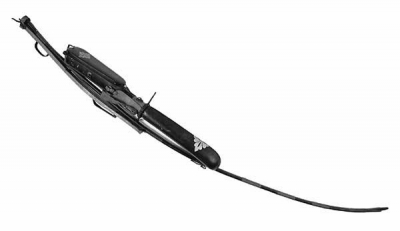Lacquered bow (1992.16.1)
 JapanLacquered bow from Japan, Asia. Collector not known. Found unentered and added to the Museum's colections in 1992.
JapanLacquered bow from Japan, Asia. Collector not known. Found unentered and added to the Museum's colections in 1992.
The massive Japnese bow (yumi) is the longest in practical use anywhere in the world. It is so long that the grip is positioned about a third of the way from the lower tip, enabling it to be used either standing or on horseback.
This example was collected in Yokohama by 1873. It measures 2.2 metres and is constructed of a rigid core of kashi ('red oak'), sandwiched between a bamboo back and belly. These three layers are glued together, and the whole construction planed smooth, then wrapped tight with rattan cane. Finally, the bow is lacquered in black, and bound in decorative red-dyed rattan bindings. The bow is shown here with its matching quiver, which contains 11 bamboo arrows and is also lacquered black with a gold floral mon (clan symbol).
Kyudo ('The Way of the Bow') is one of Japan's oldest marital arts and military archery was just as important a skill as sword fighting for the samurai warrior. However, this particular bow is for sport. Sporting archery developed in Japan in the 12th century and often involved tests of endurance such as shooting as many arrows down a covered gallery as possible in a 24-hour period.





